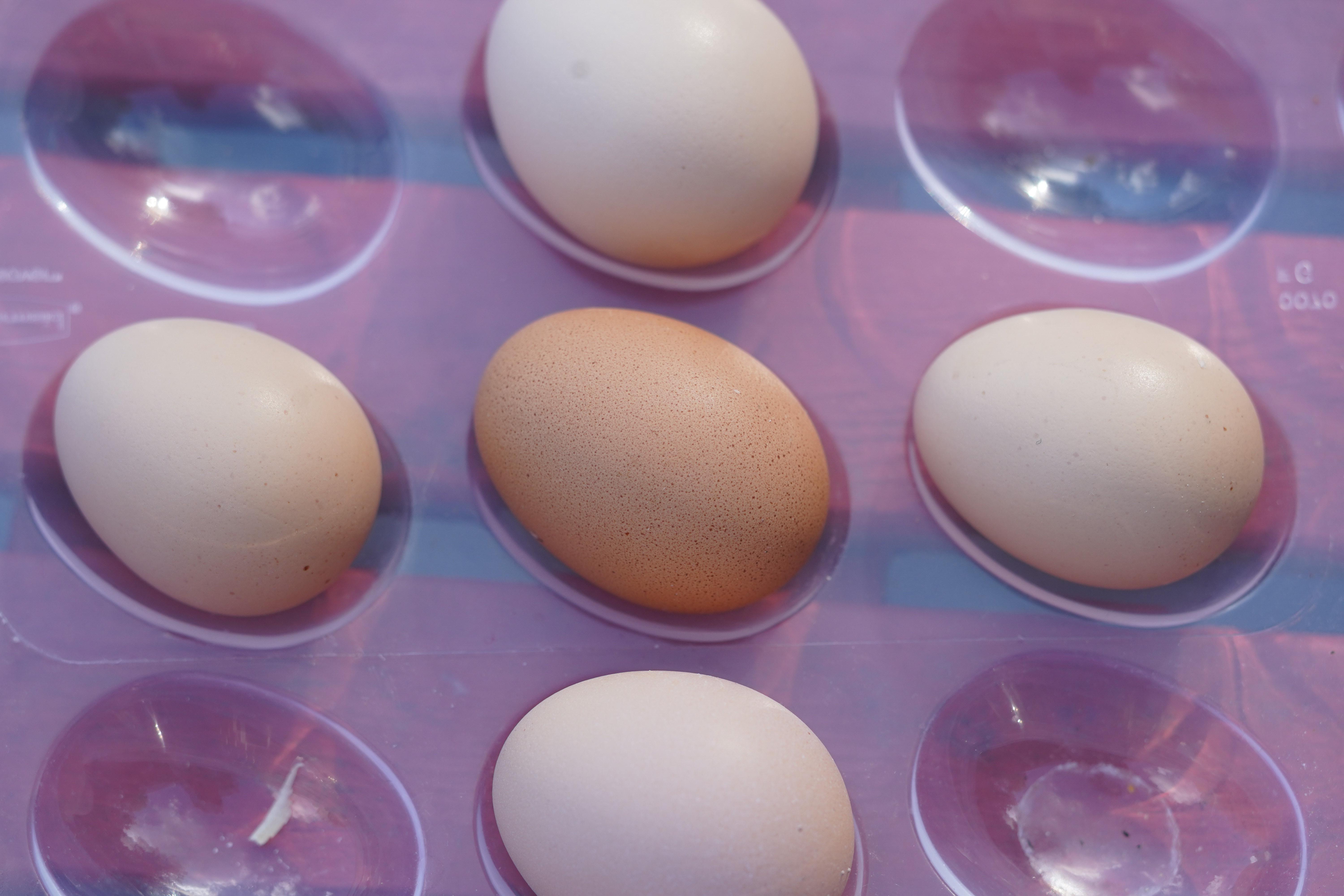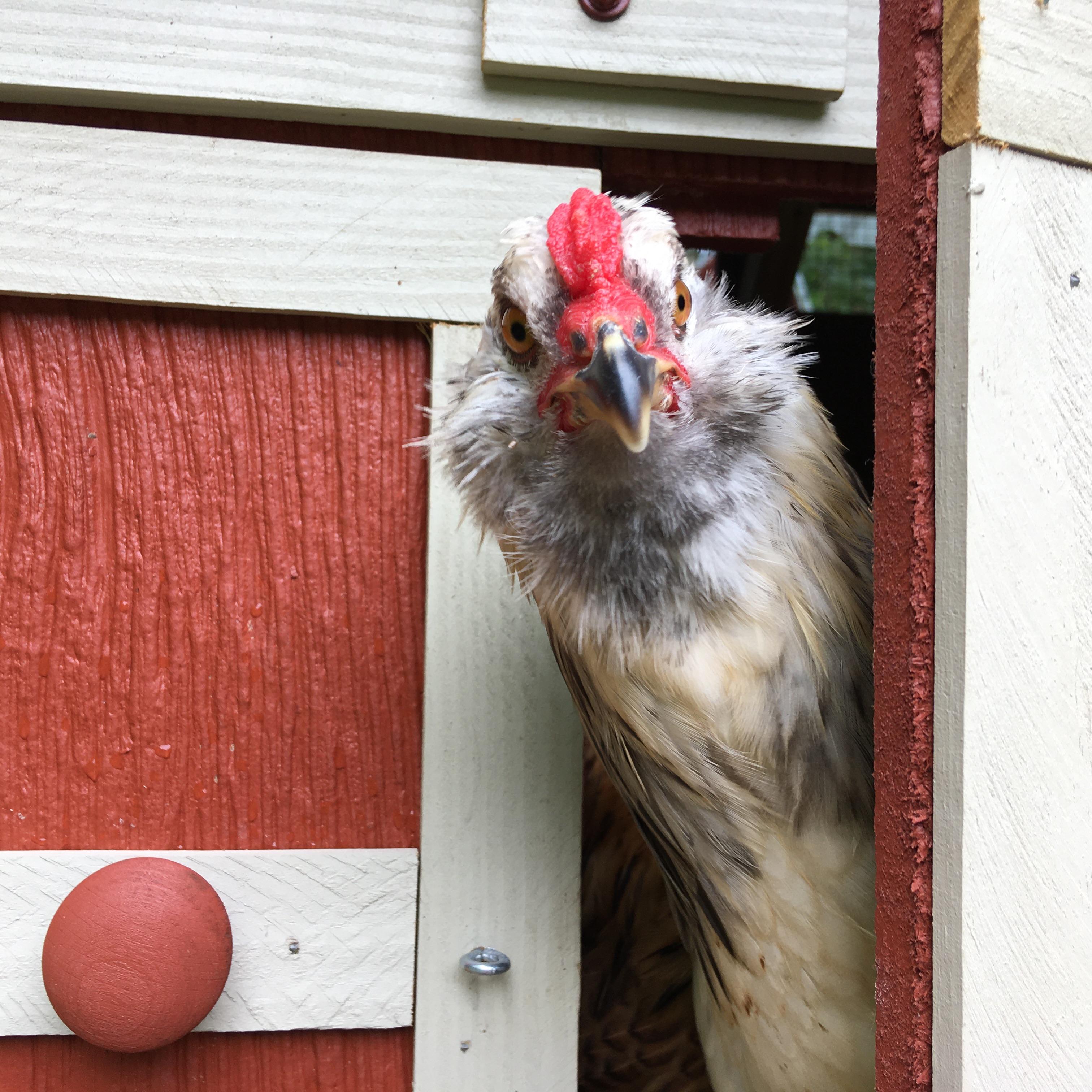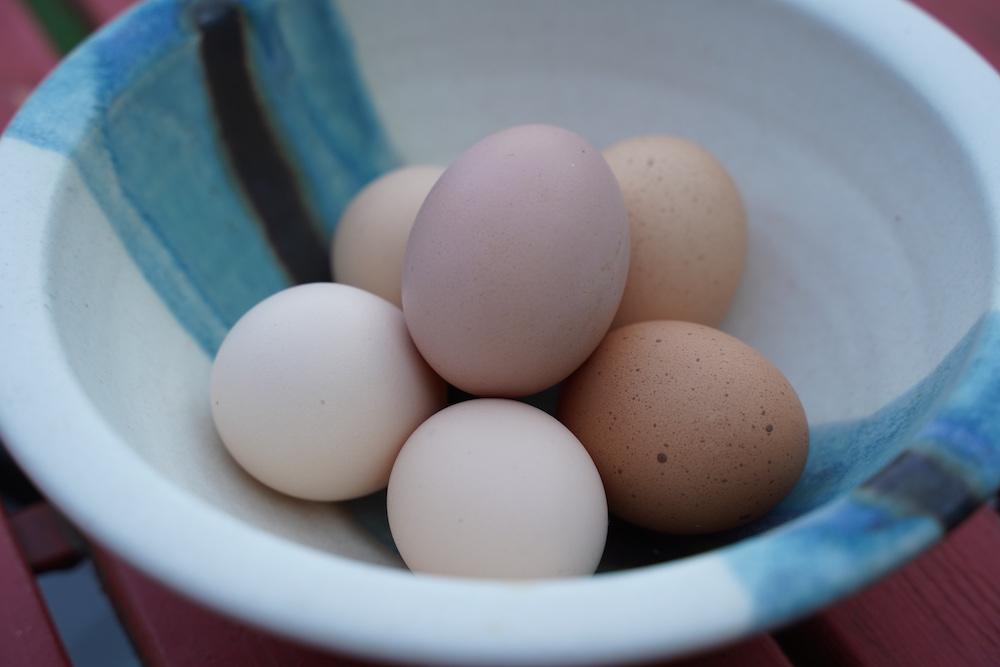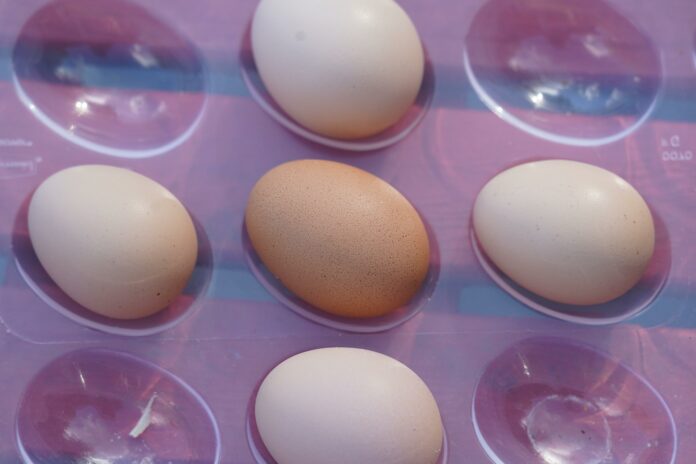by Beth
When we announced that our feathered homies had begun laying eggs this summer, loved ones asked the same questions we asked before bringing chicks home this winter.
You are viewing: Where Do Chickens Eggs Come Out
Before raising chickens, I had no idea how much I didn’t know about one of my favorite foods, eggs. I wanted to answer those great questions in a post in case you, too, need to know if eggs come out of a chicken’s butt.
Beginning at the beginning:
If you just brought home fuzzy chicks, when will you get eggs?
No time soon. Fuzzy chicks are usually a day or 2 old. Chickens don’t lay until at least 4 months. Generally…
- Hybrids, like many “production” and sexlink chickens, begin laying earlier, usually 16-18 weeks.
- Hatchery heritage breeds, like Brahmas and Langshans, often start between 20-30 weeks.
- Heritage breeds from a breeder – bred for appearance, personality, and quality of eggs over quantity – may start as the same time as their hatchery peers, but some breeds may not lay for an entire year.
Other factors include weather (many hens don’t lay in winter or extreme heat), nutrition (malnourished or obese chickens can have trouble laying), and stress like crowding, a mean rooster, or bad weather. And sometimes a hen just won’t be a big layer. Chickens are individuals.
Oh, and with chicks, you have to wait a few weeks before you know for sure how many hens you have. Chicks are hard to sex, so even if you buy “sexed pullets,” there’s a chance you’ll end up with a rooster or 3.
Note that if you hatch eggs or buy chicks “straight run,” you have a 50/50 chance of males and females. Straight run is the poultry-world’s version of “as is.” Some breeds (like most bantams) only come straight-run because sexing the chicks is too dangerous for them.
This is one reason people may choose to forgo the adorableness of baby chicks and purchase “started pullets,” female chickens old enough to clearly confirm their sex and who may be laying already.
Can you eat the first eggs chickens lay?
Several of our ladies were so surprised by their first eggs they laid them off the roost while sleeping. Those eggs broke, so to minimize losses, I piled pine chips high under their roost as a “soft landing” and snuck ceramic eggs into the nesting boxes to help them figure out where eggs go.
The day after the fake eggs were in the nesting boxes, Miss Eula laid an egg in a nesting box. Hooray, Eula! Peep, on the other hand, made a nest of the soft-landing area for a whole week before moving to a box. She is her own chicken.
Early eggs can be yolkless or go the other way, with 2 – or rarely 3 – yolks as a chicken’s system figures out how to build an egg. Miss Eula made double yolks weekly in her first 2 months of laying. They’re much larger than a normal pullet egg (see below photo of a phone charger next to a normal pullet egg and a double-yolk), so you kind of feel bad for the chicken. But I was around while she was laying some of these, and she appeared unphased.
More than once, 2 of our chickens laid double yolks on the same day, which was interesting. Look at those pretty yolks!
Lastly, early eggs’ shells may have more speckles or different color saturation than they will later in a hen’s life, or even later the same season. Because while a chicken only lays one color, the shade of the of color and speckles can change with weather and age.

Read more : Where To Stream The Superbowl
Speaking of color…
What’s up with different colored eggs?
Have you ever seen a blue egg? Or a green one with brown spots? Different breeds lay different colored eggs, from bright white to pink, blue, green, terra cotta, and even dark chocolate brown.
“Egg rainbows” are all the rage with backyard chickens right now, so if you buy chicken eggs from a local chicken keeper, you may see fun colors in the carton.
One of the most popular colored-egg layers in the United States is the Easter Egger chicken, who can lay green, blue, pink, or brown. Again, each hen only lays one color.
Easter Eggers are a mix of a white-laying breed and a blue-laying breed so can look like just about anything, but many have cute cheek poofs thanks to the blue-laying breeds (Ameraucanas or Araucanas). We absolutely love these hens and their beautiful eggs. Thanks to a sexing mix-up, we also have an Easter Egger rooster named Stilton who takes excellent care of his ladies. Here he is as a baby cockerel.

Do blue, green, or brown eggs taste different? Are they healthier?
Studies say the color of an egg’s shell doesn’t significantly affect its flavor or nutritional content. However, if your carton includes a rainbow of eggs, you probably got them from a neighbor with chickens. In comparison to commercial egg operations, conscientious backyard “chicken tenders” will feed better feed and allow chickens to roam and forage and flap their wings and be chickens.
Which equates to higher quality eggs (our eggs are so much richer and more flavorful that I’m forever spoiled for store-bought eggs) and you can rest well knowing that the contents of your grocery cart aren’t supporting terrible abuse and destruction of the environment.
Because humans have gone unbelievably off track in the way we treat our world and the other animals we share it with. The food industry is inflicting a horrific amount of damage in a struggle to support the human population while turning a profit. If you’re not raising your own food (it’s super fun; you should try it!), you can make a major difference by taking that detour on the way home from the grocery store to buy fresh eggs from the neighbor.
At the grocery store, note that the extra dollars for free-range options are worth it in the bigger picture. There’s not enough oversight of how those operations are run to know for sure how their chickens are kept, but free-range eggs indicate a higher chance those chickens at least see the sun and grass at some point in their lives. They may not have their beak tips hacked off or be crammed together beyond all reason for their entire lives, along with other brutal and completely unacceptable practices we tacitly support when we buy the cheapest eggs at the store.
I’m not on a soapbox looking down; Chris and I still rely on the food industry for most of what we eat. However, we’re also actively working to grow our awareness, shift habits, and find ways to be part of the solution.
How different are fresh chicken eggs from store eggs?
If doing good isn’t enough motivation to connect with small-scale, local farmers, do it for the deliciousness. If you cook a fresh egg in a way that showcases its flavor, you’ll taste a richness that’s hard to describe. It’s the egg version of the difference between a good wine and a 2-buck Chuck. A crispy-fried fresh egg is sublime.
If you’re making a cake, the difference is mostly visual (though expert bakers may tweak recipes due to variations in egg size or composition). The size and shape of backyard eggs will be less consistent, the shells may be interesting colors, and the yolks will be extra bright in the batter.
A note that the egg industry long ago realized that US consumers prefer dark-yellow yolks, so dyes are added to hens’ feed to produce darker yolks. This isn’t science fiction, and it’s not new: studies published all the way back in the 1930s discuss how to manipulate yolk coloring through chicken feed. Scientific interest in how synthetic dyes can affect human health is unfortunately more recent. Sigh.
Meanwhile, compounds in plants and bugs foraged naturally make our chickens’ yolks even darker than dyed commercial yolks. Our scrambled eggs glow like the briefcase in Pulp Fiction.
Another difference: if you gather fresh eggs straight from the nest, you may not have to wait for them to reach room temperature, unless you’re waiting for them to cool down. Fresh-laid eggs are warm! A chicken’s body temperature is over 100°F.
Read more : Where To Live In Alaska
Raising poultry is one way we can contribute positively and is a weight off the soul. Our chickens spend their days foraging, gossiping, chasing down bugs, dustbathing, preening, and napping together laid out under the trees. They eat nutritious feed, milled as locally or sustainably as I can find. Truly, even if we couldn’t tell a difference in the eggs, having happy chickens in the yard is priceless.
How many eggs do chickens lay?
Chickens can lay every day or every week. Their individual schedule depends on breed, age, weather, whether they’re shedding feathers (called “molting”), and more, but it takes approximately 24 hours to form an egg, so they shouldn’t lay more than once daily.
If a hen does lay 2 eggs in a day, hopefully she won’t make a habit of it. You may notice both of those eggs have a flat side. These are called “slab eggs” and look like this because there was a misfire in the hen’s reproductive tract and the eggs developed squished together.
Chickens can live into their teens, and many continue to lay through their lives, but they may lay less frequently after 2-4 years. That’s especially true with production breeds, which humans have bred to lay so many eggs they often won’t live past age 3 or 4. Laying daily is good for human-food production but awful for chickens. Production chickens may be bred to lay extra large eggs, too, which can be deadly. This is why we will never have these breeds unless we participate in any rescues from egg farms.
Our heritage breeds are supposed to lay standard-sized eggs 1-4 times a week (smaller than modern grocery store eggs so perfect for most recipes). It’s amazing how much 1-4 eggs per 6-8 hens adds up. By the time just 1/2 our pullets were laying, we were regularly collecting more than enough eggs to share.
Do you need a rooster for eggs?
No, not only do roosters not lay eggs; a hen lays eggs regardless of a rooster’s presence.
Ew, wait, can you eat the eggs if you have a rooster, or will there be chicks in them?
You can eat the eggs the same as you would with no rooster. Eggs have to spend weeks at a specific temperature and humidity level, rolled multiple times per hour, to turn into anything other than breakfast (e.g., chicks don’t appear in a basket on the counter or carton in the fridge).
Do eggs come out of a chicken’s butt?
We thank our 3-year-old nephew for this question, but he’s not the only person to ask. In fact, it was one of the first things addressed at the farmers co-op chicken class I went to this winter.
Eggs do pop out of the chicken-butt region but from an egg-only part of the chicken’s system – not the digestive tract. Hens have a special mechanism that closes off their intestine when they lay, so no there’s no contact with poop, unless you don’t keep a clean coop. If you have clean nesting boxes and the hens live on plenty of clean ground where they don’t have to walk through a lot of poop, the eggs shouldn’t need washing.
So the “my pets poop breakfast” T-shirts and hashtags are kind of true, but not really.
Wait, you don’t wash eggs?
If eggs don’t get poopy, many people believe there’s no reason to wash them. Eggs are covered in a miraculous protective layer called a “bloom.” The bloom seals an egg so bacteria can’t get in, and it may tint the shell color, like BeBe the Langshan’s “high bloom pink” egg in the photo below. It’s nature’s Glad Wrap.

The wisdom taught in the chicken classes I’ve taken at county extensions and farmers co-ops is that unwashed eggs can be stored safely at room temperature for at least a week. Washed eggs should go in the fridge. Here’s another source on that, and of course do your own research to decide on an egg-keeping method that works for you.
Are the chickens angry when you take their eggs?
Going broody is when a chicken decides it’s time to hatch eggs, even if she has no rooster. A broody hen will peck you hard when you reach for an egg.
Hens stop laying when broody, and they eat less, which can make them susceptible to illness, so people have devised all kinds of sneaky ways to make broody hens go back to “normal,” like putting a bag of frozen vegetables under the nesting material to lower their core body temperature.
Six months into chickens, we haven’t had a broody yet. Nor have we experienced plenty of other chicken milestones, but we’ll continue to share discoveries as we do. Thanks for reading, and feel free to ask other egg questions in the comments.
Source: https://t-tees.com
Category: WHERE

